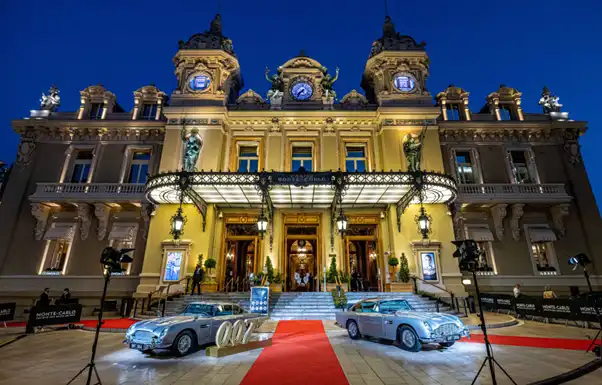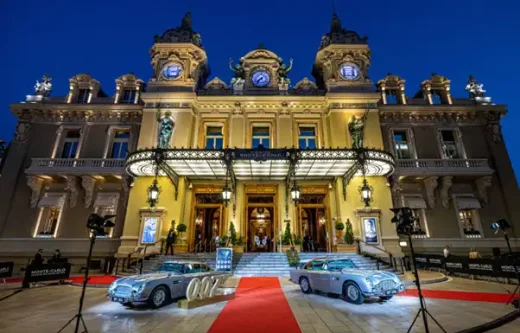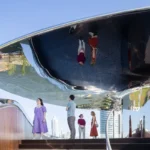Casino architecture through the ages, Entertainment hub building design, Gambling venues style
Casino architecture through the ages
17 October 2024
The evolution of casinos over time is not only a reflection of the changing nature of gambling but also a testament to the architectural trends that shape these entertainment hubs. From the modest beginnings of Las Vegas’ Fremont Street to the grand mega-resorts of the Strip, the design of casinos has evolved to reflect the social, economic, and cultural shifts of their respective eras.
Over the years, casinos have moved from simple one-story buildings adorned with neon lights to extravagant, immersive resorts offering not only gambling but a total experience—luxury, entertainment, and relaxation. Let’s explore the architectural evolution of casinos, focusing on the rise of Las Vegas and its global influence on casino design.
Fremont Street: The Birthplace of Las Vegas
Las Vegas, the iconic city of gambling, traces its roots back to the mid-19th century. Although settlers arrived as early as 1854, it wasn’t until 1905 that the city was officially founded. Gambling was legalized in Nevada around that time, and Las Vegas became a haven for gamblers. Fremont Street, the city’s original thoroughfare, became the heart of this newly established gambling community.
The architectural style of the early casinos along Fremont Street was defined by their modesty, with many being single-story buildings that maximized visibility through neon lights and large, eye-catching signage. Casinos like the Golden Gate and the Golden Nugget, still in operation today, represent the early architecture of Las Vegas. These buildings were designed to grab attention quickly, with bold colors, large billboards, and neon signs advertising games and entertainment, creating a vivid and bustling atmosphere.
In the modern era, Las Vegas has expanded far beyond Fremont Street, offering a variety of gaming experiences both on and off the Strip. One notable example of online gaming and casino innovation is Wanted Win Casino, which has become a popular choice for gamblers worldwide. This casino stands out with its engaging game selection, featuring a mix of slots, table games, and live casino options. With enticing promotions, including a no deposit bonus, Wanted Win Casino makes it easy for players to dive into the action without risking their own funds. Its sleek interface and commitment to player security echo the excitement and accessibility that Las Vegas is known for, but with the convenience of playing from anywhere.
This blend of tradition and innovation in casinos, both on the Strip and online like Wanted Win Casino review, continues to keep Las Vegas at the forefront of the gambling world, offering a thrilling experience to players both near and far.
The most iconic symbol of this era is the neon cowboy ‘Vegas Vic,’ who still welcomes guests today. His enormous neon figure and flashing lights were not only a draw for tourists but also an emblem of Las Vegas’ larger-than-life persona. The typical architecture of this period was driven by the need for accessibility and instant appeal. The buildings were designed to be easily recognizable, and the architecture reflected the optimism of the time—brash, bold, and colorful. This period in casino design was one of excitement, where every design element worked to make the casinos feel larger than life.
The Rise of the Las Vegas Strip: A Shift to Mega-Resorts
While Fremont Street marked the humble beginnings of Las Vegas’ gambling culture, the development of the Las Vegas Strip marked the city’s transformation into a global destination. In the mid-20th century, large hotel-casino complexes began to appear along the Strip, designed to accommodate a growing influx of tourists. These early resorts were often simple, boxy buildings designed to maximize the available space, and they combined hotels, restaurants, and casinos under one roof.
As the Strip grew in size and prominence, architects began to innovate, and by the 1990s, large luxury resorts like the Mandalay Bay, the Bellagio, and the Wynn were developed. These mega-resorts introduced a new architectural approach. Gone were the small, single-story casinos of the past; in their place were sprawling, multi-story complexes with massive casino floors, elaborate water features, and iconic interior design. The goal was to create immersive environments where guests could indulge in luxury without ever needing to leave the resort. The resorts were no longer just places to gamble—they were destinations in themselves.
One of the defining features of this new wave of casinos was their opulence. The interiors of these resorts were designed to evoke grandeur and elegance, incorporating materials like marble, gold accents, and Venetian-style waterways (as seen in The Venetian), while the exterior architecture often borrowed from classical and European designs. At the Bellagio, for example, visitors are greeted by a stunning Italian-inspired courtyard, complete with a famous water fountain that performs choreographed shows. Similarly, the Venetian recreates the romantic ambiance of Venice, offering gondola rides inside the resort. These casinos were designed to be more than just places to gamble; they were full-fledged resorts that offered entertainment, shopping, fine dining, and luxury accommodations—all in one location.
Global Influence: The Spread of the Casino Resort Concept
The success of Las Vegas and its architectural innovations did not go unnoticed. As the casino-resort model proved successful, other cities around the world sought to replicate its formula. While Las Vegas remains the ultimate destination for tourists seeking the “full” casino resort experience, cities like Atlantic City, Macau, and Reno have embraced this model with their own architectural styles and resort complexes.
Macau, often referred to as the “Gambling capital of the world” after Las Vegas, has adopted many elements from the Strip’s casinos. The design of Macau’s mega-resorts, like the Venetian Macau and Galaxy Macau, incorporates massive casino floors, luxurious accommodations, and a variety of entertainment options that cater to both gamblers and tourists looking for a full vacation experience. Similar to Las Vegas, these resorts in Macau integrate entertainment, dining, and gambling into one cohesive experience, offering a wide range of amenities under one roof.
Cities like Atlantic City have also embraced the concept of casino resorts, though with a more modest and classic design compared to Las Vegas. While Atlantic City’s resorts are not as extravagant as those found on the Strip, they still incorporate elements of luxury, leisure, and entertainment. The evolution of casino architecture globally has been about creating spaces that offer more than just gambling—they are immersive destinations that attract visitors for much more than their gaming opportunities.
Sustainable and Modern Trends in Casino Architecture
In the last decade, there has been a noticeable shift toward sustainability in casino architecture. As global awareness of environmental issues grows, many casinos have embraced sustainable building practices to reduce their carbon footprint and promote environmental stewardship. This shift is evident in the construction of new resorts, which often include eco-friendly features like solar panels, energy-efficient lighting, and the use of recycled materials.
Sustainable casino resorts not only prioritize energy efficiency but also incorporate biophilic design elements that blend nature with architecture. This design philosophy promotes the inclusion of natural elements like indoor plants, green walls, and natural lighting, creating healthier and more aesthetically pleasing environments for visitors. This trend aims to enhance the well-being of casino patrons while also lowering the environmental impact of these large-scale resorts.
Additionally, advancements in technology have transformed casino design in recent years. Many casinos now utilize smart technology to manage energy usage, enhance security, and improve guest experience. Features like automatic lighting adjustments based on the time of day, temperature controls, and even automated concierge services have become common in modern resorts. These technological innovations allow casinos to operate more efficiently, while providing guests with a seamless and luxurious experience.
Conclusion: Casinos as Cultural and Architectural Icons
From the humble beginnings of Fremont Street to the luxurious mega-resorts of the Las Vegas Strip and beyond, the evolution of casino architecture mirrors broader societal changes. The early casinos reflected the excitement and optimism of their time, while the mega-resorts of today cater to the desire for immersive, luxury experiences. Las Vegas has set the standard for the casino resort model, and its architectural innovations have influenced cities around the world.
As the future of casino architecture unfolds, we can expect to see even more focus on sustainability, technology, and biophilic design. These developments will not only shape the physical appearance of casinos but also enhance the overall experience for visitors, offering them a complete escape from the ordinary. Casinos have evolved from simple gambling halls to cultural and architectural landmarks, providing spaces that blend entertainment, luxury, and sustainability.
Comments on this guide to Casino architecture through the ages article are welcome
Casino Buildings
Casino Building Designs
5 most beautiful casino buildings in world
Casino Architecture Design Guide
Buildings
Contemporary Property Articles – recent architectural selection from e-architect below:
London Architecture Designs – chronological list
Comments / photos for the Casino architecture through the ages page welcome






